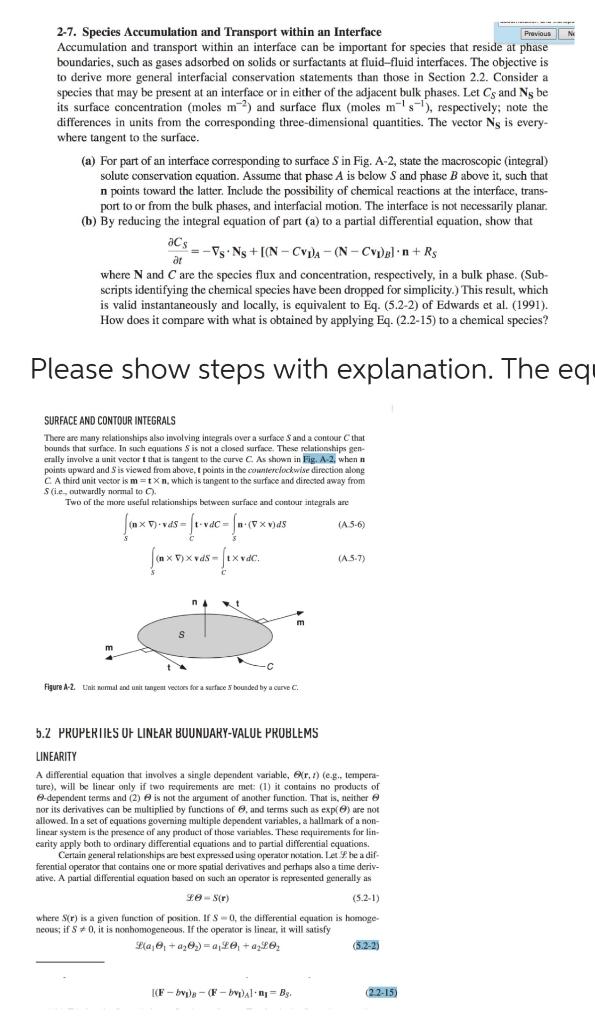
2-7. Species Accumulation and Transport within an Interface Accumulation and transport within an interface can be important for species that reside at phase boundaries, such as gases adsorbed on solids or surfactants at fluid-fluid interfaces. The objective is to derive more general interfacial conservation statements than those in Section 2.2. Consider a species that may be present at an interface or in either of the adjacent bulk phases. Let CS and NS be its surface concentration (moles m2 ) and surface flux (moles m1s1), respectively; note the differences in units from the corresponding three-dimensional quantities. The vector NS is everywhere tangent to the surface. (a) For part of an interface corresponding to surface S in Fig. A-2, state the macroscopic (integral) solute conservation equation. Assume that phasc A is below S and phase B above it, such that n points toward the latter. Include the possibility of chemical reactions at the interface, transport to or from the bulk phases, and interfacial motion. The interface is not necessarily planar. (b) By reducing the integral equation of part (a) to a partial differential equation, show that tCS=SNS+[(NCvD)A(NCvL)B]n+RS where N and C are the species flux and concentration, respectively, in a bulk phase. (Subscripts identifying the chemical species have been dropped for simplicity.) This result, which is valid instantaneously and locally, is equivalent to Eq. (5.2-2) of Edwards et al. (1991). How does it compare with what is obtained by applying Eq. (2.2-15) to a chemical species? Please show steps with explanation. The eq SURFACE AND CONTOUR INTEGRALS There are many relationships also imolving invegrals over a surface S and a contour C that bounds that surface. In such equations S is not a closed sarface. These relationships generally involve a unit vector t that is tangent to the curve C.s shown in Fig. A2, when n points upward and S is viewed from above, t points in the connerefock wise direction along C. A third unit vector is m=tn, which is tangent to the surf ace and dirested away from S (i.e. , outwardly normal to C ). Two of the more useful relationships between surface and contour integrals are S(n)vdS=CtvdC=sn(v)dSS(n)vdS=CtvdC. Figure a-2. Uhit wimal and ueit tangent vectoes for a surfice 5 bounded by a cure C. .2 PRUPERIIES UF LINEAR BUUNUAKY-VALUL PRUBLEMS LINEARITY A differential equation that involves a single dependent variable, (r,t) (e.g., temperature), will be linear only if two requirements are met: (1) it contains no products of -dependent terms and (2) is not the argument of another function. That is, neither nor its derivatives can be multiplied by functions of , and terms such as exp ) are not allowed. In a set of equations goveming multiple dependent variables, a ballmark of a nonlinear sysem is the presence of any product of those variables. These requirements for linearity apply both to ordinary differential equations and to partial differential equations. Cenain general relationships are best expressed using operator notation. Let he a differential operator that contains one or more spatial derivatives and perhaps also a time derivative. A partial differential equation based on such an operator is represented generally as Q=S(r) where S(r) is a given function of position. If S=0, the differential equation is homogeneous; if S=0, it is nonhomogeneous. If the operator is linear, it will satisfy L(a11+a22)=a11+a2E2 [(FbvI)B(FbvI)A]nI=BS







